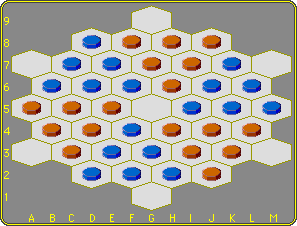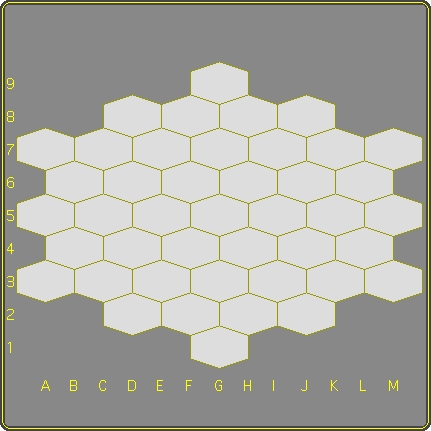Yet, apart from the obvious difference of Focus being played on a square grid and Crossfire on a hexagonal one, there's one big difference: in Focus the 'capacity' of every square - the maximum stack it will hold - is five men. Any stack surpassing this number is reduced to five by taking the excess from underneath, whereby the opponent's men are captured, and friendly men are kept as 'reserves' that may be re-entered on the board.
In Crossfire the capacity of a cell equals the number of adjacent cells! Corners will hold at most a stack of two, sides at most three or five, and cells of the inner area at most six.
This gives rise to a strategy not possible in Focus: moving big stacks onto 'low-capacity' cells, corners in particular. This way considerable numbers of prisoners can be made and reserves created on fixed target cells. In Focus for instance one can never make prisoners, nor create reserves, by moving a stack onto a vacant square. In Crossfire, moving a stack of five onto a vacant corner renders three men. This fixed element makes Crossfire more of a strategy game than its predecessor.
Play Crossfire interactively
 | Rules If there's mention of men and pieces, a man is single, while a piece consists of a number of stacked men. If the difference doesn't matter, a man may also be referred to as a piece, for instance 'the number of pieces on the board'. Object
The diagram shows the board with the pieces in the initial position. The coordinates of a cell can be found by looking along the ranks and alternating files to obtain the letter and number. |
- There are two players, 'black' and 'white'.
- Players move, and must move, in turn. White moves first.
- A piece consists of one or more stacked men. It may be composed in any way. The top man determines its owner. Players move only their own pieces.
- A move consists of either:
- picking up the piece - or any number of top men of the piece - and moving it the number of cells equal to the number of men that are moved, in one of the six main directions.
It does not matter whether, or by whom, the target cell is occupied. - entering a 'reserve' on any cell (except if excluded by the ko rule).
It does not matter whether, or by whom, the target cell is occupied.
- picking up the piece - or any number of top men of the piece - and moving it the number of cells equal to the number of men that are moved, in one of the six main directions.
 | The diagram shows white's options for the piece of five - he may move ...
|
 | The capacity of a cell
|
 | Overcapacity
|
 | The 'ko-rule'
This example is not meant to illustrate any strategy, only the mechanics involved. Other pieces, prisoners and reserves have been left out for clarity. Let's assume that white has created a stack of six on c5 by moving a white-black-white stack onto a black-white-black one, and that black has next put a reserve on top of a white single on g1. The position is now as depicted in the diagram. |
It is now white's turn. If he enters on g1, he immediately regains his reserve, which means that he effectively only reverses the colors of the stack. Now black cannot enter on g1 because he would, with the same move, recreate a position that already occured!
But black can enter on top of the six, also immediately regaining the reserve and effectively only reversing the colors of the stack. The difference is that white now still can enter on the six. Although he in doing so recreates a position that already occured, he does so with a different move (since he first created the stack by moving a white-black-white stack onto a black-white-black one).
Black now of course cannot enter on either stack, though he may do so as soon the position as a whole has changed.
The ko-rule has been introduced for precisely the type of situation depicted here: even numbered maximum capacity stacks with alternating colors that, by nature, can be reversed while all else remains exactly the same.
Note: the ko-rule equally applies to odd-numbered alternating stacks, though not all remains the same there, because the moving player captures an opponent's man rather than a reserve. That's why no ko-rule is necessary in Focus: the situation sorts itself out by dwindling numbers. Situations involving alternating 5-stacks in Crossfire, if at capacity, may therefore have their own tactical implications.
|
How I invented ... Crossfire External links | ||||||||
Crossfire © MindSports



